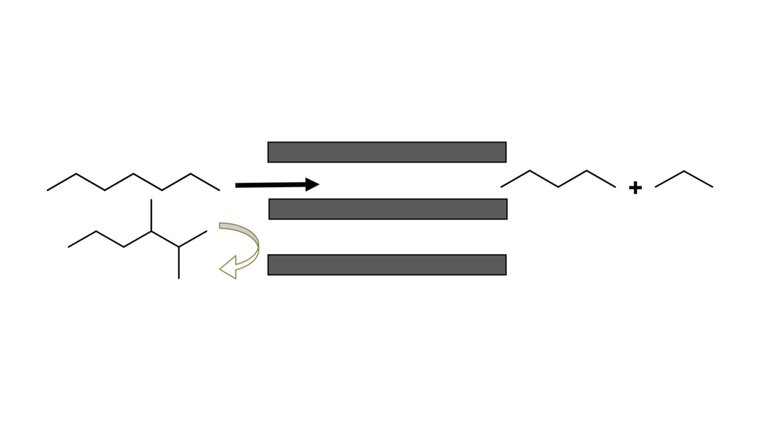Properties of Zeolites: The 3D Molecular Sieves |ChemFam #33|
Greetings to all my deal fellow Hivians. In my last post, we were discussing about the basic structure of zeolites and preparations of two of the most widely used zeolites. We also have understood why it is called as the molecular sieves. We have gone through the compositions of various zeolite molecules. Today, we shall discuss some of the important properties of zeolites that are worth mentioning. So, let’s directly jump to the properties of zeolites.

High Surface Area and Ordered Pore Structure
We have already studied the pore characteristics of zeolites. These are highly porous structures. The high surface area and orderly arranged pore structure of zeolites results in their unique adsorption properties. The high surface area of zeolites are due to their highly porous nature. The typical range for surface area of zeolites ranges from 600-800 m2/g. As a result of this high surface area, zeolites can absorb large quantities of adsorbate. The adsorption of adsorbate though highly depends on adsorbate size, aperture size, temperature and surface acidity of zeolites.
Zeolites have pore diameter of the order of molecular dimension, so molecules having diameter of the same order or larger than pore diameter cannot pass through the pores and hence are excluded from entering the pores or the structured supercages. Due to the exclusion of larger molecules, preferential adsorption and reaction can be done using zeolites. For example, separation of N2 and O2 in air can be done using a mixture of 13X-NaX zeolites.
Acidity
Zeolites possess OH bridging sites due to the water molecules present in them. The OH bridging between a framework of Si to that of Al acts as the Bronsted acid site. The coordinately unsaturated Al sites give rise to Lewis acid character and this acidic nature of zeolites increases with decreasing Si:Al ratios. This is because acid sites are associated with Al ions. These Bronsted and Lewis acid sites play important roles in various catalytic reactions involving hydrocarbons. Zeolites are used in catalytic cracking reaction in petroleum industry.
Thermal Stability
Most of the zeolites are stable upto a critical temperature of 400°C. The stability of zeolites increases with increase in the silica content. The thermal stability of zeolites can increase upto 800°C by the introduction of rare earth cations.
Shape Selective Nature of Zeolites
Zeolites are also known as shape selective catalysts due to their unique pore structure. The unique pore structure of zeolites results in its high shape selective properties. The shape selective nature of zeolites results due to,
- Geometric restriction on the access of reactants to the zeolite framework.
- Geometric restrictions on diffusion of reactants in or diffusion of product out from catalysts.
We shall now discuss the reactant and product selectivity which is of our interests.
(1) Reactant Selectivity: The selective admission of reactants into the zeolite pores due to the restriction in pore size is known as reactant selectivity. For example, in the case of cracking of hydrocarbons such as n-heptane undergoes preferential cracking (relative rate of 1 unit) over dimethylhexane (relative rate of 0.09 unit). The dimethylhexane is unable to enter the zeolite pores due to the presenceof branched carbons in their structure.

(2) Product Selectivity: The selective formation of a certain product is basically product selectivity. Selective formation of a certain product can occur when there is a possibility of formation of multiple products. It is due to the restriction on size or the diffusion rates of larger molecules. It can be best explained by taking the example of alkylation reactionnof methylbenzene over pentasil zeolites. The probably products could result in p-xylene, m-xylene or o-xylene. Thus, all possible three isomers could be obtained in the reaction. However, due to restriction on pore diameter in pentasil zeolites, there is preferential production of p-xylene over ortho and meta forms.

(3) Molecular Traffic Control: This concept mainly involves preferential diffusion of reactants through one channel and diffusion of products out of another interconnected channels of a zeolite. The counter diffusion is minimised and product selectivity is maximised by this process.

In a number of zeolites diffusive transport takes place in quasi one dimensional channels where the guest molecules may block the movement of each other. Due to this mutual blockage of reactant and product molecules under such conditions, the effective reactivity of a catalytic process (which can be determined by the residing time of molecules inside the zeolite) may be considerably reduced as compared to the reactivity in the absence of single file behaviour. This results in a very low yield of product molecules from the catalytic grain. In order to overcome this problem, the concept of molec- ular traffic control (MTC) was suggested. In the MTC there are spatially separated pathways for the reactant and product molecules. This avoids the mutual suppression of self diffusion in the grains and thus reduces the residing time.
We shall discuss the applications of zeolites in the next post. I’m wrapping up my post for today but will see you guys soon.
New Technology - Mod4 - NPTEL Chem Eng
Zeolites: The 3D Molecular Sieves |ChemFam #32|
The Beauty of Eucalyptus Tree |ChemFam #31|
The Accidental Cure for Cancer: Cisplatin |ChemFam #29|
Acceptorless Dehydrogenation and Related Transformations |ChemFam #28|
Thermophysical Properties of Natural Gas-I |ChemFam #27|
Sources and Process Overview of Natural Gas |ChemFam #26|
Recovery, Upgradation and Purification of Helium in Natural Gas |ChemFam #25|
Trace Components in Natural Gas System |ChemFam #24|
Sulphur Recovery in Natural Gas System-II |ChemFam #23|
PS The thumbnail image is being created by me using canva.com taking template image from ASDN


This post has been manually curated by @bhattg from Indiaunited community. Join us on our Discord Server.
Do you know that you can earn a passive income by delegating to @indiaunited. We share more than 100 % of the curation rewards with the delegators in the form of IUC tokens. HP delegators and IUC token holders also get upto 20% additional vote weight.
Here are some handy links for delegations: 100HP, 250HP, 500HP, 1000HP.
100% of the rewards from this comment goes to the curator for their manual curation efforts. Please encourage the curator @bhattg by upvoting this comment and support the community by voting the posts made by @indiaunited.
Thanks for your contribution to the STEMsocial community. Feel free to join us on discord to get to know the rest of us!
Please consider delegating to the @stemsocial account (85% of the curation rewards are returned).
Thanks for including @stemsocial as a beneficiary, which gives you stronger support.